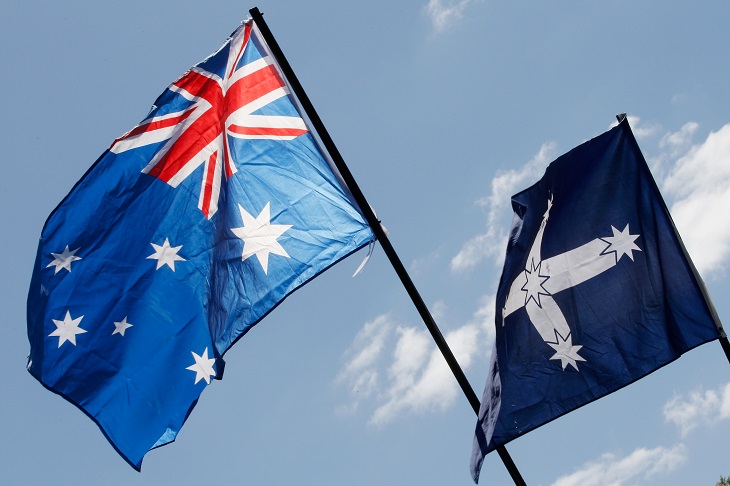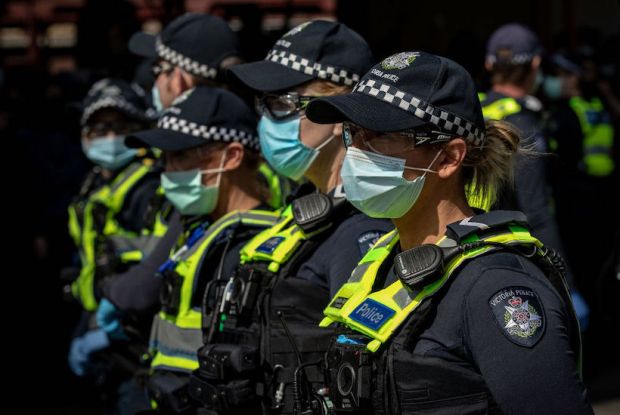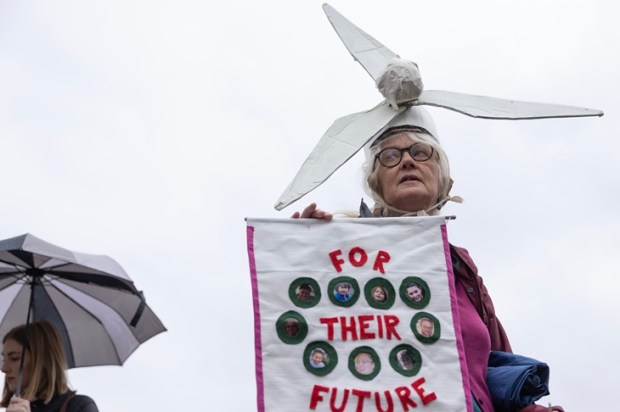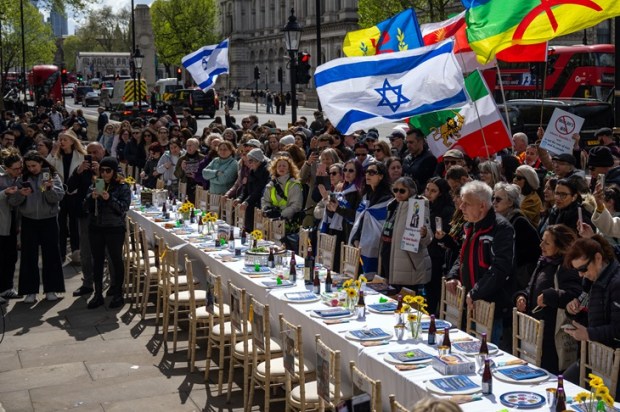There’s a band of people who see themselves as the ‘keepers’ of the Eureka Stockade tradition, and they are much miffed by anti-Covid lockdown protesters who wave the Eureka flag. The ‘miffed’ are principally unionist, republicans, and avowed leftists who hold that their causes shine bright under Eureka’s Southern Cross. To them, lockdown protesters are engaged in the theft of (their) sacred symbol.
But there are parallels between the Eureka rebellion and the anti-lockdown protests that give the current-day protesters some justification for flying the Eureka flag.
Eureka The Unfinished Business by Peter FitzSimons gives a highly detailed account of the ‘massacre’ (the term used by the Melbourne media at the time) just after dawn on Sunday, 3 December 1854. Some 30 ‘diggers’ were killed in a brutal 20-minute attack by colonial soldiers against the Eureka Stockade at Ballarat. Soldiers fell along with unknown other diggers – potentially several hundred – that died subsequently from horrendous wounds.
The seeds of the massacre were laid some short 20 years earlier when Melbourne was founded by a near lone explorer, John Batman. The ‘village’ and Victoria exploded in population to some 250,000 after gold was discovered in 1851 – not just ‘gold’ but massive nuggets were literally sitting under the soil, easily picked up by the lucky finder.
The Victorian colonial government appointed from London had a degree of local parliament, but the representatives were elected only by landholders (squatters). These lucky first settlers of Victoria had received huge land grants from the government, paid a small annual rent to the government, then acquired wealth on the back of wool and related grazing activity. These 4,000-or-so elite individuals were effectively a social and political nouveau riche aristocracy.
The gold rush induced not only a huge immigrant population explosion, but a rush of squatters’ workers and every other type of worker to leave their jobs for the lure of riches in the goldfields. The colonial government faced a big revenue shortage and so imposed a monthly mining levy on every goldfield digger whether the digger had found gold or not.
This levy, often violently enforced by the police, was the core reason for the Eureka revolt. Their ‘revolutionary’ theme was ‘no taxation without representation’.
The Eureka revolt is a symbol for some modern Australian republicans because some diggers, mainly Irish, added a republican agenda to the diggers’ cause. This divided the diggers.
Karl Marx himself, who wrote his Communist Manifesto in 1848, showed great interest in the diggers’ 1850s rebellion. In 1855 Marx opined that the rebellion was the workers’ proletariat rising up against the ruling bourgeoisie just as he predicted. This was enough for today’s political Left to grasp Eureka as their symbol of the inevitability of the workers’ revolution.
It was out of this Marxist idea of the endless struggle of the workers versus the bosses (however defined) that was – and remains – a central idea of the Australian union movement and the Australian Labor Party. As the primary funders and factional controllers of the ALP, Australian unions fly and display the Eureka flag at all opportunities.
But here’s where the truth of Eureka breaks from the symbolic myth and connects to the Covid ‘rebels’, particularly in Victoria.
The diggers were self-employed. They were ‘workers’ and ‘bosses’ all in one. This shatters the Marxist, Leftist, unionist myth. The Eureka revolution arose from ‘workers’ who deserted their ‘bosses’ to become their own bosses. They took their luck in the marketplace of gold prospecting. Their revolution was against the bureaucratic government elite who sought to (and did) distort their free market, thereby creating massive harm. The elite cared not for the harm they did.
Likewise the Covid ‘rebels’ are drawn heavily from the ranks of the self-employed. Under Covid, self-employed and small business Victorians have carried the financial burden, with some pushed into comparative poverty. These are the people most damaged by the world’s longest and harshest Covid lockdown – all staged in Victoria.
Look at the Victorian ‘revolution’…
Construction workers massed against and attacked their own union. A huge police presence was needed to protect the union ‘bosses’ in their Elizabeth St Melbourne citadel. Repeated weekend after weekend, huge but peaceful (even polite) rallies stretched from the gold rush funded Victorian Parliament House to the end and beyond of the 3 km Bourke St main city strip. Drone footage interposed with computer analysis put crowd numbers around some 120,000 at its peak.
And where do these Covid rebels come from? Mobile phone tracking analysis identifies the bulk of them from Melbourne’s outer ring of suburbs. These are the homes of the mortgage strugglers and low-income earners, says the analysis. They are heavily the self-employed hairdressers, personal trainers, tradies, and more.
These are the people who’ve carried the financial burden of the Covid lockdowns. Anyone on the financial teat of a heavily indebted, harsh, authoritarian Victorian Covid government has financially sailed through. Here is where the Covid government played the politics of dividing the community; to oppose the Covid policies was – and is – to be considered as scum.
Such was the story also of colonial Victoria. The Colonial Governor ran the line that the Eureka rebels threatened the very safety of the colony and the population.
Both the colonial and Covid Victorian governments resorted to harsh, even brutal police action. The Eureka Stockade massacre was the end product of increasingly brutal police tactics in enforcing the diggers’ licence. The firing of rubber bullets by Victoria’s anti-terrorists squad into the backs of fleeing Covid demonstrators was the end product of months of police activity arresting demonstrators for not ‘locking down’.
In 2020, Victoria police arrested a pregnant mother for ‘sedition’ because she expressed her anti-Covid policy opinion on Facebook. Thirteen of the Eureka ‘rebels’ were likewise charged with sedition and High Treason. All 13 rebels were found not guilty at trial. Common to both the colonial and Covid Victorian governments was the affront they took toward anyone seen to be defying their authority.
Sedition is the ‘crime’ of inciting people to rebel against authority. So obsessed were both governments with enforcing their authority that they blinded themselves to their own massive mismanagement that caused the defiance.
The colonial Governor repeatedly insisted on enforcing the diggers’ licence even after many deputations warned him of the consequences. The ‘Covid Premier’ Daniel Andrews oversaw a months-long disastrous hotel quarantine program that lead to 801 deaths and then reacted by imposing the world’s harshest and longest lockdown.
The Victorian Colonial Governor’s own inquiry found that it was the government’s maladministration caused the Eureka disaster. Similarly, the Victorian Covid government’s inquiry also found that it was government maladministration of hotel quarantine that lead to the initial wave of 801 deaths in 2020.
It is these similarities between the Eureka and Covid rebellions that stand out most in giving the Covid ‘rebels’ the right to wave the Eureka flag. Such similarities overpower unions, Leftists, and republicans who also claim a right to use the flag.
In 2004, on the 150th anniversary of Eureka, Eureka author John Molony stated, ‘Democracy is much more than a system. It is an ideal and a spirit born day by day in those who believe in it.’ How true.
Perhaps it is a strange quirk of Australian history that the core of both the Eureka and Covid rebellions is in Victoria. The starkest reason is that with Eureka and Covid, the Australian state with the harshest, most authoritarian, unyielding, manipulative, and even violent government occurred in Victoria. Strange indeed.
The Colonial Governor and government had a military victory in crushing the Eureka rebellion. Within a short year or so the government’s authority amongst the people had crashed and the Governor resigned. By 1859, along with a wave of democratic reform, Victoria had the vote for all males in a new Legislative Assembly. (Women had to wait another 50 years!) But the dominance of the landed elite was suppressed, spelling the death of a looming landed gentry class.
The Victorian Covid government seemingly won the lockdown battles of 2020-21. But history is yet to play out as to whether their authoritarianism prevails over a living day-by-day democracy.
Ken Phillips is Executive Director of Self-Employed Australia.
Got something to add? Join the discussion and comment below.
Get 10 issues for just $10
Subscribe to The Spectator Australia today for the next 10 magazine issues, plus full online access, for just $10.

























Comments
Don't miss out
Join the conversation with other Spectator Australia readers. Subscribe to leave a comment.
SUBSCRIBEAlready a subscriber? Log in